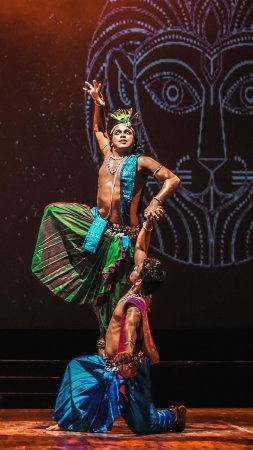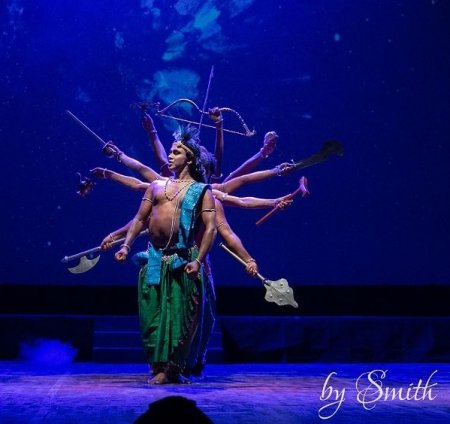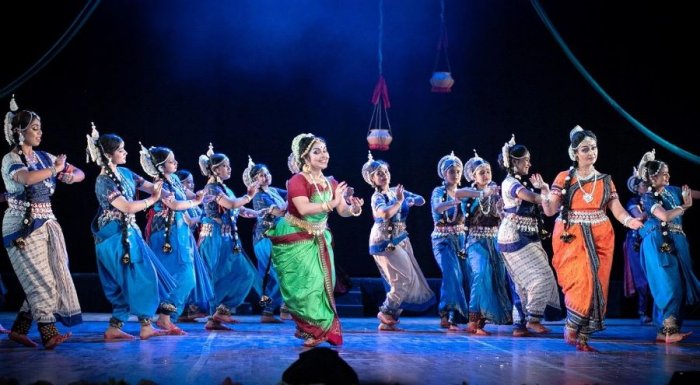
|   |

|   |
Mayur Lalit Dance Academy's evening of dance - Tapati Chowdhurie e-mail: tapatichow@yahoo.co.in July 11, 2023 A sixteen member team of Orissa Dance Academy from Bhubaneswar, nurtured by its versatile Artistic Director Aruna Mohanty, who wears the mantle of her late Guru Gangadhar Pradhan - founder of the institution - was invited to Kolkata to perform at Mayur Lalit Dance Academy's recent festival of dance at Rabindra Sadan.  Geeta Mahatmyam 'Geeta Mahatmyam' based on the eternal truths professed in the Gita as relevant today as it was in ancient times, was a unique presentation by her group. In the battle field of Kurukshetra, Arjuna is crestfallen at the prospect of having to kill his own near and dear ones. His charioteer Krishna, an incarnation of Vishnu, reveals to him the soul's timeless, formless quality that has no beginning or end. Aruna Mohanty, who has numerous productions to her credit, has not limited herself here in only revealing of the Bhagavat Gita in the battle field of Kurukshetra or merely talking to Arjuna on the Gyana Yoga or Karma Yoga. Krishna has revealed to Arjuna the limitless quality of the soul which cannot be shredded by weapons or burnt by fire, or wet by water or dried by the wind. In fact, Geeta Mahatmyam has captured many other aspects of the life of Krishna. Krishna's persona in his leelas that speak about his love dalliance with mortals, represented by Radha and the gopis, signifying the individual soul's yearning for the Supreme has been captured too. Besides she has very deftly given a vivid example of Karma Yoga by including a scene, where the great karma yogi Gandhi has found his truth in treading the path of Ahimsa or non-violence. Aruna Mohanty has explored the ten incarnations of Vishnu in Dashavatar to show the redemption of mankind. The idea of Vishnu coming to the earth in different forms explored the philosophy of "Sambhavami yuge yuge" - Lord Krishna's profound statement which says that he will come to this world to redeem mankind, as different avatars. Krishna tells Arjuna, "Whenever there is a decline of righteousness (dharma) and rise of unrighteousness, then I send forth myself. For the protection of the good, for the destruction of the wicked, and for the establishment of righteousness, I come into being from age to age." Arjuna realises that the battle of Kurukshetra is not a literal physical battle, but representative of the battles within each one of us.  Geeta Mahatmyam The presentation showed a thorough understanding of time and space. Each and every dance unit had the perfection that comes from practice, practice till it reaches perfection and the dancers dance like apsaras who have woken up from their static poses carved on ornate temple structures soon to return. The effect was magical. The dance of the male performers enacting Krishna and Arjuna was amazing. They underwent transformation, which are marks of good dancers. Visual poetry was created on the proscenium stage; the familiar content was palpably intense because of its classicism. Typical Odissi costumes in appropriate colours enhanced the beauty of the drama. Perfection in every aspect created rasa. Though the language of dance was sufficient by itself to convey the story, props were used for emphasis. A master choreographer, Aruna's boundless power of conceiving ideas gave birth to 'Geeta Mahatmyam' launched for the first time in Chennai with Janardhan Raj Urs choreographing the segment of contemporary dance used in the production; Gauri Diwakar, the skilled Kathaka of the Jaipur Gharana choreographing the Kathak portions, Anita Guha choreographing the Bharatanatyam portions, while the total concept and choreography was Aruna Mohanty's. However Aruna presented 'Geeta Mahatmyam' in Kolkata scripted by Kedar Mishra, with scholarly inputs by Pt. Nityananda Mishra, with the repertory members of Orissa Dance Academy in pure Odissi dance style. Music was composed by Guru Ramhari Das, while Guru Dhaneswar Swain did the rhythm composition. Ramesh Chandra Jena did the light designs, which were creative and appropriate. Janardhan Raj Urs and Biswajit Das did the visuals. Back stage management was by Pramod Rout. It was a neat production.  Balya Leela The second half of the evening was also on Krishna - the incarnation of Vishnu. The Artistic Director of Mayur Lalit Dance Academy, Debamitra Sengupta, and her young students - hundred and thirty of them - took a dip into the life of Krishna when he was a child. Besides his innocent child-like activities, Krishna had time and again resorted to the display of his divine qualities, whenever the situation so demanded. The dance drama 'Balya Leela' was based on Padabali Kirtan - devotional music of the Vaishnava community of Bengal. Lord Krishna's masculine grace with sportive spirit was beautifully portrayed. Performance of the beginners to the Odissi form was nuanced. The eternal and omnipotent lord with his limitless consciousness exudes unlimited bliss. This difficult concept was handled with much care and patience. Some among the group are sure to make it big. In spite of being just beginners who need to mature as dancers, their enthusiasm and earnestness aroused vatsalya rasa.  Balya Leela The rendition of these child dancers made 'Balya Leela' quite entertaining. They need all the encouragement to keep going. Their mentor Debamitra Sengupta was in the role of Krishna's mother Yasoda, Alakananda Datta in the role of Rohini, a queen of Krishna, Adheya and Ukti as Krishna, Subhangi and Aaditri as Balaram. The storyline using the usual known episodes from the life of young Krishna like stealing butter, Gostha Leela, Krishna's love for Radha and the Brajabalas of Vrindavan were danced with joy. It was interesting to see child Gopal's antics. Vocal renditions of Kirtan and the narration were by Seema Acharya Chowdhury, Sri Khol research and execution was by Goutam Bhattacharya.  Tapati Chowdhurie trained under Guru Gopinath in Madras and was briefly with International Centre for Kathakali in New Delhi. Presently, she is a freelance writer on the performing arts. |